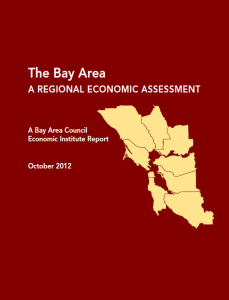 The Bay Area: A Regional Economic Assessment
The Bay Area: A Regional Economic Assessment
Bay Area Council Economic Institute
Haveman, Kallerman, et al.
First published October 2012
Download ResourceThe analysis has been framed with two principal objectives: to comprehensively assess what is driving the regional economy from the perspective of competitiveness, growth, and jobs, and to identify impediments to stronger growth and job creation. While the Economic Institute has not been asked to develop detailed recommendations or to present a comprehensive economic strategy—which would be a much larger undertaking—this study does suggest paths forward whose implementation could serve as the basis for such a strategy. At the heart of these suggestions are the ideas of public-private partnership and closer collaboration between business and government to strengthen the region’s economic competitiveness and enable the creation of jobs across the economic spectrum. These objectives have two important sub-themes: inclusive growth that provides opportunities for low and moderate-income communities, and sustainable growth that reduces greenhouse gas and other emissions through better planning.
This study finds that the Bay Area enjoys unique economic assets that have enabled it to prosper across economic cycles. It finds that a strategic focus on the sectors where it is most competitive and which have defined its global leadership offers the best opportunity to generate future jobs and growth. It also finds growing economic inequality, and a risk that significant parts of the population won’t share in the region’s general economic success. The question that presents itself is, despite the region’s present economic strength, could its economy be even stronger and could it be generating more jobs for more of its residents if a number of impediments could be overcome? This raises issues such as housing cost and availability, congestion, regulatory efficiency, and a lack of strategic focus on regional economic priorities. These concerns point to the need for both a more effective partnership between business and government on economic issues and a stronger sense of shared purpose surrounding growth and development. The study concludes by making suggestions for meeting these needs. More immediately, however, it is designed to provide a shared foundation of facts and analysis on which both government and business can build a closer strategic partnership.
